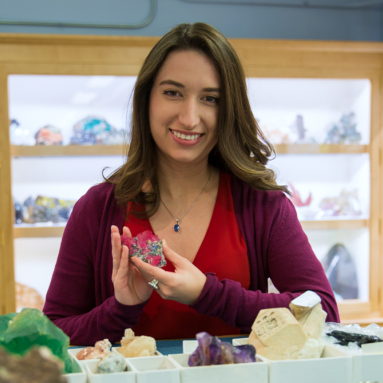June Speaker: "What Crystallography Can Teach Us About Biominerals and Other Behind-the-Scenes Highlights at the Smithsonian NMNH," by Dr. Gabriela Farfan
by Cindy Schmidtlein, MSDC Vice President for Programs

Abstract
Biominerals are minerals that are formed through the help of biological metabolisms, whether on purpose or by accident. While they may not fall under the classic definition of a mineral, biominerals are incredibly important to life on Earth, global elemental cycles, technology, medicine, and so much more. In recent years, Gabby and her team have been uncovering new ways to study biominerals from a crystallographic perspective – a perspective that had been missing from the more common biologically-focused works on these unique bio-mineral composite materials.
As a curator and scientist at the Smithsonian NMNH, Gabby splits her time between mineralogical research, collections, and mineral outreach. As part of her presentation, Gabby also will be highlighting some recent additions to the National Gem and Mineral Collection.
Biography
Dr. Gabriela Farfan is the Coralyn Whitney Curator of Gems and Minerals at NMNH and has been in charge of the National Collection for the last year. Like many gem and mineral aficionados, she began collecting gems and minerals at an early age which led her to a career in mineralogy. She has visited over 30 mines across the U.S., Canada, and Chile and has enjoyed meeting miners, gem artists, and scientists during these adventures.
After receiving her bachelor’s degree in Geological and Environmental Sciences from Stanford University, she earned her PhD in Geochemistry from the MIT-WHOI Joint Program. As a research curator and mineralogist, she studies the crystal structures and chemistry of minerals formed under varying conditions in order to answer questions in environmental mineralogy, biomineralization, and gem science. Her research primarily focuses on how aquatic biocarbonates (like coral skeletons, mollusk shells, and pearls) record shifting aquatic environments using crystallography coupled with trace element and isotope geochemistry.
In her new role, she is honored to be a steward of this legendary collection and looks forward to building the collection, making it accessible to researchers and other museums, and using it to inspire future generations of gem scientists and enthusiasts.
